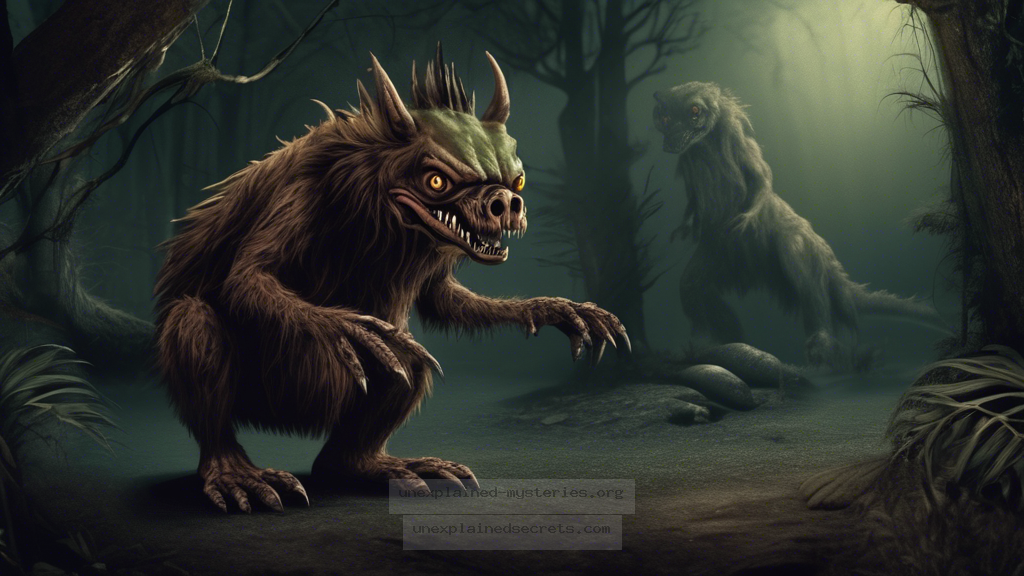What Secrets Does the Chupacabra Hide in the Shadows of Cryptozoology?
What Secrets Does the Chupacabra Hide in the Shadows of Cryptozoology?
The Chupacabra is one of the most enigmatic and perplexing figures in the realm of cryptozoology. Often depicted as a creature that drains the blood of livestock, particularly goats, this cryptid has sparked intense interest and speculation since its first reported sightings in the 1990s. But what is the truth behind the Chupacabra? Is it simply a myth, a misidentified animal, or something altogether different? In this blog post, we will delve into the depths of this fascinating mystery, exploring its history, theories, and implications.
Historical Context: The Origins of the Chupacabra Legend
The term “Chupacabra,” which translates to “goat-sucker” in Spanish, first emerged in Puerto Rico in the mid-1990s. The initial reports came from a series of livestock killings that left goats and other animals drained of blood, with puncture wounds on their necks. The first widely publicized sighting was reported in 1995 by a Puerto Rican woman named Madelyne Tolentino, who described a creature that was small, with spines along its back and glowing red eyes.
Over the years, the Chupacabra legend has evolved, with various sightings recorded across Latin America and even into the southern United States. Each account provides a slightly different description, leading to confusion and curiosity about the creature’s existence. Some describe it as a reptilian creature, while others liken it to a dog or a hairless cat. These varying accounts highlight not only the creature’s elusiveness but also the cultural significance it has developed in different regions.
Core Concepts: What Do People Believe the Chupacabra Is?
Numerous theories have emerged regarding the identity of the Chupacabra, ranging from the plausible to the bizarre. Some of the most popular hypotheses include:
- Canine Hypothesis: Many believe that the Chupacabra sightings are misidentified dogs, particularly those suffering from mange. This theory is supported by photographic evidence showing hairless canines resembling the creature.
- Alien Connection: Some enthusiasts speculate that the Chupacabra may be an extraterrestrial being, possibly linked to UFO sightings in the same regions. This theory often stems from the creature’s unusual appearance.
- Genetic Experimentation: Another theory posits that the Chupacabra might be a product of genetic experimentation gone wrong. This idea has gained traction in light of modern advances in genetic engineering.
- Folklore and Myth: Many researchers argue that the Chupacabra is a manifestation of cultural folklore, embodying fears and anxieties about livestock predation and environmental changes.
Did You Know? The Chupacabra has inspired a significant amount of pop culture, including books, TV shows, and movies, highlighting its place in modern mythology. 📺
Practical Implications: The Impact of Chupacabra Sightings
The phenomenon of Chupacabra sightings has tangible effects on local communities. Farmers in regions where livestock deaths are attributed to the creature often experience economic hardship due to the loss of their animals. This can lead to heightened fear and anxiety within communities, resulting in calls for action and investigation.
Additionally, the lore surrounding the Chupacabra has spurred curiosity and tourism in some areas, with enthusiasts flocking to purported sighting locations. While this can be economically beneficial, it can also strain local resources and wildlife, exacerbating existing problems.
Alternative Perspectives: Skepticism and Scientific Inquiry
While many embrace the Chupacabra as a legitimate cryptid, skeptics argue that the majority of sightings can be explained through rational means. For instance, many supposed Chupacabra carcasses have been identified as canids suffering from diseases that cause hair loss and emaciation, such as mange or sarcoptic mange.
Scientific investigations into the phenomenon have also sought to understand the ecological implications of these sightings. For example, researchers have studied how environmental factors, such as habitat loss and climate change, may contribute to livestock predation incidents, thereby framing the Chupacabra narrative within a broader ecological context.
Important Note: Skeptics often emphasize the need for critical thinking and scientific rigor when investigating cryptid phenomena. 🔍
Common Misconceptions and Clarifications
The Chupacabra is often surrounded by misconceptions that contribute to its mystique. Some common myths include:
- All sightings are of the same creature: In reality, descriptions vary widely, indicating that multiple creatures may be misidentified as Chupacabras.
- The Chupacabra is always a blood-sucking monster: While this is the most popular characterization, some accounts describe the creature as more of a scavenger.
- Scientific investigations are dismissive: Many scientists are open to investigating cryptids, but they emphasize the need for empirical evidence and data.
Best Practices for Investigation or Study of Cryptids
For those interested in exploring the Chupacabra phenomenon, following best practices can enhance understanding and documentation:
- Document Sightings: Keep detailed records of sightings, including time, location, and descriptions of the creature.
- Engage with Local Communities: Collaborate with local residents to gather stories and insights that may provide context to sightings.
- Utilize Technology: Leverage modern technology, such as camera traps and drones, to gather evidence without disturbing wildlife.
- Remain Skeptical: Approach each sighting with a healthy dose of skepticism and an emphasis on scientific inquiry.
Quick Tip: Always approach investigations with an open mind but prioritize evidence over folklore. ⚖️
Future Developments: Ongoing Research and Exploration
As interest in cryptozoology grows, so does the potential for new discoveries concerning the Chupacabra. Ongoing research in genetics, ecology, and animal behavior may yield new insights into the creature’s origins. For example, scientists are now able to analyze DNA from purported Chupacabra specimens, which could clarify whether these creatures are, in fact, known animals or something entirely new.
Additionally, as we continue to grapple with environmental changes, understanding the dynamics between wildlife and human agriculture may reveal more about the factors that contribute to livestock predation. The Chupacabra may serve as a focal point for studying broader ecological issues that affect rural communities.
Conclusion: The Chupacabra—A Mystery That Continues to Evolve
The Chupacabra remains one of the most captivating enigmas in cryptozoology. While the creature’s origins may be rooted in folklore and cultural fears, the ongoing interest in its sightings has sparked significant investigation and debate. As new evidence emerges and the scientific community continues to explore these mysteries, the Chupacabra serves as a reminder of the thin line between myth and reality in our understanding of the natural world.
Whether the Chupacabra is a real creature, a misidentified animal, or simply a product of cultural mythos, its story continues to captivate the imagination and inspire inquiry into the unknown. As we move forward, the journey to uncover the truth may reveal not only the secrets of the Chupacabra but also insights into our relationship with nature and the mysteries that lie just beyond our understanding. 🌌
Other Articles
Recent Posts
- What Happened to Flight MH370? The Conspiracy Theories That Still Haunt Us
- What Secrets Lurk Within the Walls of the Infamous Trans-Allegheny Lunatic Asylum?
- What Evidence Supports the Existence of Bigfoot in the Pacific Northwest?
- What Happened to the Indus Valley Civilization? Unraveling the Mysteries of Ancient Urban Life
- Can Telepathy Be Scientifically Proven Through Laboratory Evidence?







